AI and gender bias is a prevalent issue that impacts several aspects of our lives: from the design of products to the type of services provided to each respective gender. It often reflects and amplifies existing gender biases and stereotypes in society.
The gender data gap can cause significant issues and complications with results of production machine learning to end users. Let’s dive into what it is, the cause and effects, and how to prevent the gap from widening even further.
What is the gender data gap?
The gender data gap refers to the lack of adequate and accurate data on women along with their experiences, needs, and contributions to society in a variety of fields such as healthcare, education, economics, and politics.
There are several factors as to why this gap exists, including bias and discrimination in data collection, analysis, and interpretation processes. Though inclusion has improved over the years, women have also been historically excluded from decision-making positions and opportunities.
A ‘one size fits all’ approach has been taken so that data that was previously considered objective is found to actually be male-biased.
What is the cause of the gender data gap in machine learning?
Bad Data
A root cause of the AI and gender bias is bad data collection. This can happen when the training data used to build machine learning models is biased or incomplete.
One example of this is when a dataset only includes data from certain industries that are dominated by males, then models trained on that data are likely to have difficulty recognizing females in those roles. This results in models that are less accurate and potentially discriminatory.
Outliers
Outliers are another potential factor contributing to the gender data gap. They are data points that deviate significantly from the rest of the data.
So, if a dataset of salary data includes a small group of high-earning women who are outliers, then an ML model trained with this data might learn to associate women with high salaries. Discrimination can happen against women who fall outside the small subset of high earners.
Drift
Drift happens when the data that a model was trained on no longer reflects current reality. If circumstances change, performance can suffer and the model may no longer be suitable for deployment.
If a model was trained on data from several years ago when certain professions were male dominated, but the situation has changed, the model may not accurately recognize women in those occupations.
Drift can happen over time as society progresses and new data becomes available. Machine learning models require ongoing monitoring and retraining of models to make sure that they remain accurate and unbiased.
What problems are being faced by women because of AI and gender bias?
AI and gender bias can lead to a range of negative consequences. These include continued gender-based discrimination and inequality, public policies that don’t accurately address gender-specific issues, and lack of understanding of the full extent of women’s contributions to society.
In Caroline Criado Perez’s book, Invisible Women: Exposing Data Bias in a World Designed for Men, she says “The gender data gap can have life or death consequences for women, such as in medical research, where women are often excluded from clinical trials or where the symptoms of heart attacks in women are not recognized.”
One obvious group that is excluded from medical trials for moral and ethical reasons is pregnant women. However this leads to many drugs and treatments being unsuitable for pregnant women by default as they haven’t been tested and don’t want potential lawsuits.
This type of gender bias in the medical industry can lead to a lack of data on how drugs and treatments can affect women differently than men. If a woman is prescribed drugs or treatments that haven’t yet been tested on women, then it may not be the appropriate treatment for her condition.
More examples of gender data gaps in Machine Learning models
Natural Language Processing (NLP) is a very common branch of artificial intelligence that combines computer science, AI, and linguistics. NLP is often used in AI systems such as Amazon’s Alexa and Apple’s Siri, and has been found to have gender biases.
Voice-recognition technology appears to have a gender data gap because the audio analysis struggles with voices that are breathier or more high-pitched. The underlying reason is that there’s much less data on female voices. If a machine learning model is trained using mostly white male voices, it will undoubtedly not perform as well with data it sees less frequently like female voices.
Another case of gender bias is when computer vision APIs judge by appearance, just like their human creators do. Controversial applications of AI such as surveillance and profiling can connect things like visual appearances to harmful assumptions and stereotypes.
How to close the gender data gap
There are many steps that machine learning practitioners can take to eliminate gender bias in AI. The first step is understanding where bias is likely to show up in a machine learning workflow.
Sometimes, gender bias can be extremely obvious– but as Criado Perez notes, sometimes it can be very subtle. In those instances, it can be so systematically ingrained that we don’t even notice it.
For example, Cornell deployed a word embedding algorithm that examined the presence of gender bias in customer reviews. The results of 11 million online reviews were that women tended to be more commonly associated with negative attributes rather than positive ones.
The next step to closing the gender data gap is to ensure diverse data sets are being used. It’s important to establish that the individuals collecting, annotating and validating the data are diverse and representative of both genders. Data cleaning, pre-processing, and augmentation can help when mitigating bias in data.
Algorithms should be evaluated for fairness and clear accountability mechanisms established. This will help in providing transparency in algorithmic decision making.
The future of the gender data gap in AI
The gender data gap is a significant challenge that has several contributing factors that of course won’t get solved overnight. But for change to occur, it will require ongoing attention and effort from machine learning researchers, policymakers, and industry leaders.
By continuing to prioritize diversity and transparency, we can create a future for AI systems that is more accurate, fair, and inclusive for everyone.








